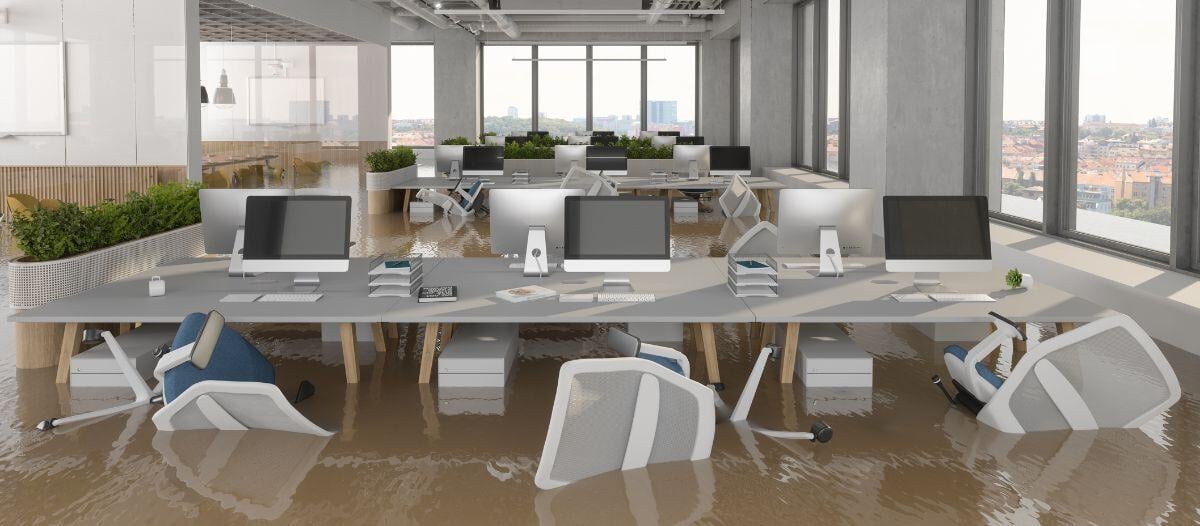Managing Water Emergencies
Insights & lessons learned from recent incidents

Water-related emergencies pose significant challenges to facility operations, requiring swift responses and coordinated efforts to minimize damage, ensure safety and restore normalcy. Recent events and incidents such as burst pipes in schools and hospitals, illustrate the pervasive risks and underscore the importance of preparedness, advanced technology to locate the source of the problem and collaboration in addressing such crises.
Addressing a water outage at Fort Defiance Hospital
On Nov. 15, 2024, Fort Defiance Hospital (Arizona, USA) experienced a water outage at 5a.m. due to a water main break in the local community. The break, managed by the Navajo Tribal Utility Authority (NTUA), caused low water pressure at the hospital, significantly impacting operations. Ice machines were taken offline, and patient care areas required alternative arrangements for hygiene and sanitation.
The hospital’s facility management team implemented emergency measures to maintain functionality and patient safety. Bottled drinking water was distributed to patient areas, water barrels were filled for handwashing and restroom use, and portable handwashing stations and toilets were brought in. Nonessential restrooms were closed, and the local fire department was alerted to maintain a fire watch during the outage. Communication with the NTUA ensured updates were received as repairs progressed. By 11:30 a.m., water service was restored, and the hospital’s environmental services team worked diligently to clean and reset impacted areas.
Despite the challenges, Fort Defiance Hospital’s emergency preparedness plans enabled continuity of operations. The incident highlighted the vulnerabilities of rural areas with limited alternative water sources and the necessity of exploring options like installing water tanks to mitigate future risks.
The broader impact of water emergencies
Water-related disruptions are not isolated incidents. They can occur in various settings, from health care facilities to schools and office buildings. For example:
-
Duke University Hospital, Durham, North Carolina, USA: On Dec. 26, 2024, a chilled water pipe burst, flooding the emergency department and adjacent areas. Ambulance traffic was redirected and patients were treated in unaffected areas or a mobile unit outside. The hospital’s rapid response, aided by local EMS and community partnerships, minimized the impact on patient care.
-
Des Moines (Iowa, USA) Christian School: A six-inch water main break caused US$75,000 in damages, disrupting operations and requiring extensive repairs.
-
Umatilla High School, Pendleton, Oregon, USA: A burst sprinkler pipe in an electrical closet during winter break led to flooding across multiple classrooms and administrative offices. Prompt action by the FM team and local fire department limited further damage and ensured the building was ready for students’ return after the holiday break.
These cases illustrate the unpredictable nature of water-related emergencies, which can stem from infrastructure failures, extreme weather or maintenance lapses. The consequences include operational disruptions, financial losses and safety risks.
Leveraging technology for prevention & response
Advances in technology have enhanced FM’s ability to effectively prevent and respond to water emergencies. Tools such as water leak sensors, automatic shut-off valves and smart building management systems offer critical advantages:
-
Water leak sensors: These devices detect moisture early, allowing facility managers to address issues before they escalate.
-
Automatic shut-off valves: These systems isolate affected areas quickly, minimizing damage and downtime.
-
Smart building systems: Integrated monitoring and control functions provide real-time insights, enabling proactive management of potential risks.
-
Mobile devices: Quickly identify shut-off locations and share building plans and evacuation routes, if necessary, with first responders.
Locating shutoffs
Locating shutoffs can often be a complex and frustrating task for FMs, maintenance teams and emergency responders. Several factors contribute to the difficulty of finding these critical components, which are essential for isolating utilities such as water, gas and electricity during maintenance or emergencies. Understanding these challenges is key to addressing the issue and ensuring smoother operations and safer environments.
-
Inadequate documentation: One of the primary reasons shutoffs are difficult to locate is the lack of accurate or updated documentation. Many facilities have undergone renovations, expansions or changes in ownership over time. During these transitions, the original plans and schematics may become outdated, misplaced or incomplete. Without a clear and current map of the facility's infrastructure, locating shutoffs is like searching for a needle in a haystack.
-
Poor labeling and signage: Even when shutoffs are accessible, they are often poorly labeled or not labeled at all. This issue is especially prevalent in older facilities where consistent labeling standards may not have been established or maintained. Faded or missing labels can make it challenging for personnel to quickly identify the correct shutoff during an emergency, potentially leading to delays in resolving critical situations.
-
Hidden or inaccessible locations: Shutoffs are frequently installed in locations that are not easily visible or accessible. They may be hidden behind walls, above ceilings or in locked utility rooms. In some cases, their placement may have been influenced by architectural constraints or a lack of foresight about future maintenance needs. Accessibility issues can be exacerbated in facilities with complex layouts, such as hospitals, industrial plants or sprawling campuses.
-
Aging infrastructure: Older facilities often have aging infrastructure that complicates locating shutoffs. Piping and wiring systems may not conform to modern standards or layouts, and shutoffs may have been installed in unconventional or nonstandard locations. Additionally, over time, components may become obscured by dirt, debris or corrosion, further hindering identification.
-
Lack of training and institutional knowledge: Turnover among maintenance staff and facility managers can lead to a loss of institutional knowledge. When experienced personnel leave without passing on their expertise, the remaining team may struggle to locate shutoffs, particularly if they rely on undocumented information or memory. New employees may also lack the training needed to understand complex utility systems and locate critical components efficiently.
-
Emergency situations: During emergencies, the urgency of the situation can make locating shutoffs even more challenging. Fires, floods or structural damage can obscure access points or make certain areas unsafe to enter. The stress and time pressure associated with emergencies further complicate the task, highlighting the need for clear, preplanned strategies.
To address these challenges, organizations must invest in comprehensive documentation and regular updates to reflect any changes in infrastructure. Implementing standardized labeling and signage can greatly improve visibility and ease of identification. Conducting routine training sessions for staff and creating detailed, accessible maps of utility systems are also critical steps. Additionally, organizations should consider leveraging technology, such as mobile devices, to create dynamic and easily navigable records of shutoffs and other critical components.
By proactively addressing these issues, facility managers can ensure that shutoffs are easier to locate, improving both operational efficiency and safety during routine maintenance and emergencies.
Adopting such technologies enhances resilience and reduces repair costs and downtime. Additionally, many insurance providers offer discounts for organizations that implement water detection systems for their facilities, adding a financial incentive to invest in these solutions.
Preparedness through training & protocols
While technology plays a vital role, robust preparation and training are equally essential. FM teams should:
-
Develop clear protocols: Emergency plans must detail specific actions for various scenarios, including the location of shut-off valves and contact information for key personnel.
-
Conduct regular training: Simulations and drills help staff understand their roles and build confidence in executing emergency procedures.
-
Maintain readiness: Routine inspections and preventive maintenance identify vulnerabilities before they lead to significant issues.
Proactive measures can mitigate risks and ensure a swift, organized response when incidents occur. For example, during the Fort Defiance Hospital water outage, the FM team’s preparedness and adherence to protocols enabled efficient deployment of resources and minimized disruptions to patient care.
Collaboration & recovery
Recovering from water disasters often requires collaboration with specialized mitigation companies and insurance providers. These experts assess damage, extract water, dry affected areas and prevent issues like mold growth. Comprehensive documentation, including photos and videos, can streamline insurance claims and provide insights for improving future responses.
Post-incident analysis is a crucial step in the recovery process. Facility teams should evaluate their response, identify areas for improvement and update emergency plans accordingly. Such reviews ensure continuous learning and build resilience against future emergencies.
Insights from real-life incidents
Water-related emergencies demonstrate the critical importance of preparedness, technology and collaboration. Each incident offers valuable lessons:
-
Duke University Hospital: Highlighted the need for rapid coordination with local EMS and community partners during large-scale disruptions.
-
Umatilla High School: Underscored the importance of addressing vulnerabilities, such as unsealed holes, that can expose systems to freezing temperatures.
-
Fort Defiance Hospital: Emphasized the challenges faced by rural facilities and the potential benefits of investing in alternative water sources, such as storage tanks.
Enhancing resilience with modern tools
Modern platforms enable FMs to access critical building information instantly, even during emergencies. Mobile accessibility allows technicians to address issues quickly and effectively, reducing response times and minimizing damage.
Water emergencies are an inevitable challenge for facilities, but preparation, technology and collaboration can mitigate their impact. By learning from past incidents, adopting advanced tools and fostering strong partnerships, organizations can enhance their resilience and ensure continuity of operations. As demonstrated by these FM teams, a proactive approach to water-related risks safeguards operations and the communities they serve.

Jack Rubinger has more than 20 years of B2B writing, public relations, and marketing experience. Rubinger earned a bachelor of arts in journalism from Binghamton University in New York. He is a frequent contributor to facility management, technology, construction, healthcare and industrial safety publications and blogs.
Read more on Risk Management , Operations & Maintenance and Project Management or related topics Emergency preparedness, response and recovery , Facility Resilience and Risk Management
Explore All FMJ Topics









